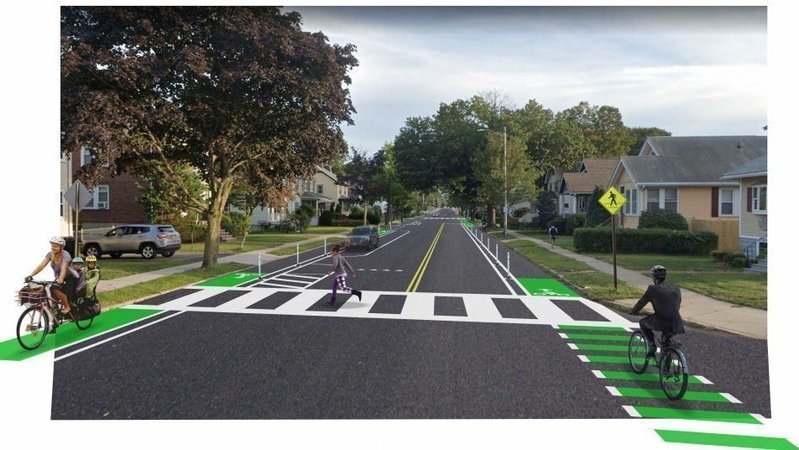(UPDATE: want to share your support for the pilot directly with the city, or give feedback on how the final implementation could be even safer? Make sure to fill out the community survey here. You can also email sharedstreets@cityofmelrose.org with your feedback!)
One of the key goals of the Melrose Pedestrian-Bicycle Committee has been to advocate for making the lower Main Street corridor from West Wyoming Avenue to the Malden line safe and comfortable for residents, visitors, workers, and all users of the corridor regardless of what method of transportation they choose. The attraction of Pine Banks Park and the limited parking at Oak Grove (in normal times) attract a variety of users including pedestrians, cyclists and transit riders with various levels of mobility.
All road users currently face a corridor that encourages high traffic speeds well beyond the citywide 25 mph limit and in many places even enables impatient motorists to seriously endanger others by passing other vehicles or MBTA buses. Current accommodation of pedestrians and bicycles is woefully inadequate with few crosswalks, dangerous bicycling conditions, and high-speed unchanneled traffic. Residents of the corridor crossing the street to access MBTA buses, for example, face a daunting road width and fast traffic. The current conditions are especially dangerous for children, seniors, and people with disabilities.
The width of the existing corridor and the scheduled repaving provides a great opportunity to reduce traffic speeds, better accommodate all users and make the street more livable for current and future residents. A repaved corridor that is not reconfigured to calm traffic will result in even higher speeds and a greater threat to safety. We recognize that the needs of all users, while having much in common, are not exactly the same and that a balance is needed to fairly address all these needs. When our Committee learned of the city’s plans to repave this corridor, we published a document which outlined numerous potential proposals, from a “bare minimum” option which re-striped the corridor, to a best-in-class option with a separated travel lane for bicycles, scooters, and wheelchair users. All of our proposals were designed to place the needs of vulnerable road users and transit riders first, and featured numerous traffic calming elements which slowed vehicular travel as well, making the corridor safer for drivers too.
The principles which guided our designs — using modern traffic calming methods, including separated facilities for active travel — have been shown in study after study, in cities throughout the country and the world, to reduce the chances of serious traffic injuries and fatalities while raising rates of active transportation, especially among demographics who might not otherwise feel safe enough to bike in the street. When we published those documents we also created a local petition which has currently garnered more than 500 signatures specifically in favor of enhanced pedestrian and bicycle access on Lower Main Street.
Among our key recommendations:
- Traffic should be channeled into striped 11 foot lanes with no opportunities provided for passing. This will help reduce speeds and the current dangerous behavior exhibited by some motorists.
- A minimum of four additional crosswalks should be provided along the length of the corridor with sidewalk bumpouts to shorten crosswalk lengths and Rectangular Rapid Flashing Beacons (RRFBs) where feasible to protect pedestrians.
- Bicycle lanes should be provided along the length of the corridor with the lanes separated from traffic by a buffer where feasible, as shown on the proposed plan. It is critical to acknowledge that studies have shown painted bike lanes, in many contexts, do not measurably improve road safety. Providing buffers is necessary to achieving our community’s goals of truly making cycling safer and more accessible.
- Delineation of bus stops along the corridor should be improved, using pavement markings.
- The Sylvan Street intersection with Main Street should be reconfigured to enhance the safety of pedestrians and cyclists accessing Pine Banks park, businesses on the west side of Main Street and Oak Grove station.
- The Banks Place intersection with Main Street should be reconfigured to enhance access to Oak Grove station for bicyclists and pedestrians while better accommodating the safe movements of MBTA buses on to Banks Place.
We appreciate the City’s implementation of a pilot project to test ideas for reconfiguring the lower Main Street. We also understand that the current poor condition of the roadway does not permit all concepts to be fully tested. It is important that this be taken into account in designing and drawing lessons from the pilot.
When the city put together its 2017 Master Plan, it did a survey at the Victorian Fair asking people which community attributes were most important to them. The number one response, by a wide margin, was the ability to get around by rail, bus, bicycle, walking, and driving — in other words, exactly the sort of opportunity the city can bring to reality through this project. The PBC stands ready to engage further with the City in advancing and evaluating the pilot as well as implementing the final project.

